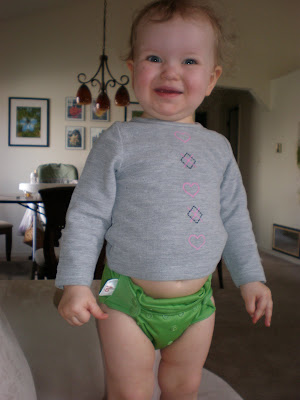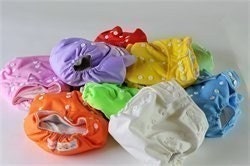I did it. I just bought the cloth diapers. I hope we like them!
In case you're curious, I thought I would do a follow-up post detailing my decision-making process. I'm not going to list every diaper I considered, because this post would be 400 pages long. After weeks of (obsessive) research*, I limited my options to three systems.
This diaper will fit a baby from 7 to 35 pounds because of its adjustable snap design. You set the snaps to fit your baby and only adjust it when the baby grows, closing the diaper with velcro for each change. This diaper has a pocket where you stuff one or more cloth inserts for varying absorbency. They cost $17.95 each (including two inserts), with discounts for buying multiples.
I was completely sold on this system until I realized that I will have two babies in diapers for at least 6 months. While a one-size system would normally be more affordable (you just buy one set of diapers instead of three sets, size small, medium, and large), in my situation, I would need to buy more diapers. I estimate that I would need 24 diapers for the new baby (which will hopefully last 3 days between laundering) and an additional 12 diapers for the toddler. The cost of 36 diapers, including inserts, is $610.
This diaper is also a one-size system, fitting babies from 7 to 35 pounds. Each diaper includes a waterproof cover to which you add either a reusable cloth insert or a disposable insert for traveling. The waterproof shell can simply be wiped clean and worn again and again between washes. The waterproof covers (including an insert) cost $16.95 each and additional cloth inserts cost $4.95 each.
This is the most affordable system I considered. For two children wearing diapers, I would only need to buy 8 diapers (4 for the new baby and 4 for the toddler to get through 3 days between laundering, assuming one clean cover per day with a backup just in case) and 28 additional cloth inserts (for the new baby, 20 additional ones plus the 4 that come with the covers to get through 3 days, and for the toddler, 8 additional ones). The total for this system would be $274.
This is also a hybrid diaper, similar to the Flip. Each diaper includes a cover, a snap-in waterproof liner, and either a reusable cloth insert or a disposable (biodegradable/flushable) insert. This is not a one-size diaper, so you need to buy three complete sets: small, medium, and large. The covers (including two snap-in waterproof liners) cost between $11.66 and $18.99 each, depending on color/pattern and whether you buy multiples at once. Additional cloth liners cost $2.50 each.
With this system, I would need to buy 4 covers in each size plus 24 cloth inserts for size small and 12 cloth inserts for sizes medium and large. I won't go into the details of the discounts offered for buying "starter packs", but it made more sense to buy 6 small covers and 24 small inserts (totaling $169), 6 medium covers ($70), 6 large covers and 12 medium/large inserts (totaling $109). The total for the entire system is $348.
In the end, I actually didn't go with the cheapest option. I went with the gDiapers, and the reason is somewhat embarrassing....they're cuter! The one-size diapers tend to look pretty bulky on a newborn, but the gDiapers provide a more fitted look. I figure that since I will potentially be saving thousands of dollars in the long run, I can pay an additional $74 up front for the cuteness factor :).
Accessories purchased:
TOTAL SPENT TO SWITCH TO CLOTH DIAPERS: $425.95
(Although the start-up costs were only about $187 including the size large gDiapers, inserts, and accessories. I'll buy size small and medium later, assuming I like them).
I will be sure to let you know how it works out!
*The Colorado Springs based online store, A Diaper Change, was very helpful in my decision making process. Their prices, which are competitive, are the prices quoted here.























